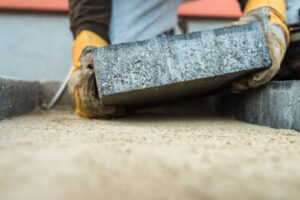Many homeowners wish to create a relaxing landscape for themselves and their families. But extensive landscaping comes with a maintenance cost.

Lines are the visual guides that bind your landscape together. Curves and straight lines add interest and character. They also affect the atmosphere of a space. For instance, straight lines feel more formal and structured while curved lines are more casually inviting. Visit https://www.jupiterlandscaping.net/ to learn more.
A well-maintained landscape combines the beauty of greenery and hardscapes to create a relaxing, inviting space. Landscaping is also a way to increase the value of your property. A professional landscaper can transform any dull, boring backyard into a space you and your family will enjoy spending time in.
Plants play a crucial role in landscaping. They help to protect soil, improve airflow, reduce energy costs, and provide shelter for wildlife. They can even repel mosquitoes and other insects that may cause health problems for people and pets. Incorporating native plants into your landscaping helps to promote biodiversity. These plants are adapted to local climate conditions and require less water and fertilizer than non-native plants. They also support local pollinators and provide habitats for wildlife, which are essential to a healthy ecosystem.
Having attractive, functional landscapes on your property can draw in customers and employees. This can increase the morale of your staff, boost the company image and generate more revenue for your business. You can also use landscaping to promote your company’s values and brand in a way that will last longer than a simple giveaway or a flier at a job fair.
Beautifully designed landscaping is also an excellent way to show your appreciation and gratitude for the community. For instance, you can donate a tree or flowers to a local charity, which will bring a sense of fulfillment and pride to your team. In addition, you can incorporate a memorial garden in your yard to commemorate loved ones.
Many people are aware of the environmental benefits of landscaping, but they are not always sure how to incorporate it into their homes or businesses. A professional landscaper will be able to guide you through the process. They can recommend different species of trees, shrubs, and flowers that will grow well in your area. They can also help you to choose the best colors and textures for your landscape design.
Landscaping is an art and science that has been around for centuries. In fact, some of the world’s oldest gardens and ruins are located in Egypt and Syria. The importance of landscaping has grown over the years, and it now includes a wide range of projects, from small residential gardens to commercial spaces.
Hardscapes
Hardscapes are the non-living elements of a landscape design. They include things like walkways, patios, retaining walls, and water features. They can add texture and contrast to the surrounding vegetation, and they can also make it easier to navigate a property. When designing a hardscape, it’s important to keep in mind that these structures should complement the plant life rather than detract from it.
One of the most popular uses for hardscapes is to create seating areas. Whether it’s a simple patio or a full-on outdoor kitchen, these structures can make your outdoor space more functional and enjoyable. They can also increase the value of your home.
Well-designed hardscapes can help prevent slips and falls, making them a great choice for commercial properties. They can also make it easier for individuals with mobility issues to move around. Using materials that match the architecture of your home or business can help achieve a unified look that’s both attractive and cohesive.
A great hardscape design will incorporate different textures to capture the eye and draw people in. It will also incorporate a focal point to captivate attention and anchor the design. Focal points can be as small as a stone fire pit or as large as a water feature. They can even be used to highlight a special tree or shrub.
Adding hardscapes to your property can give it an updated, more modern look and feel. They can also help to reduce the amount of maintenance your yard needs. For example, pavers and paving stones require less maintenance than grass or plants, as they don’t need to be regularly watered or mowed.
While a beautiful landscape is important, it’s also essential to have functional spaces for relaxing and entertaining. Having a deck or patio, for example, can make it easy to host barbecues and family gatherings, or just relax with a book. It can also increase the value of your home and be a big selling point for potential buyers. A professional landscaper can help you choose the best hardscapes for your property. They’ll take into account the purpose of your space, your budget, and your lifestyle to help you select the best features for your property.
Lighting
Landscape lighting is often the unsung hero of your exterior design, providing beauty, functionality and safety to your landscaping. When used strategically, it can illuminate pathways, highlight architectural features and create a warm and inviting atmosphere after dark. But there are many things to consider when designing your landscape lights.
There are many different types of lighting to choose from, and each one has its own unique effect. Accent lighting is a popular way to draw attention to specific elements of your landscape, such as a statue, water feature or thriving tree. This type of lighting can also be colored to help create a custom effect. Shadowing is another technique that uses a light source angled in front of an object to create a shadow effect and add depth to your space. Washing is another popular landscape lighting technique that uses a light to “wash” over an object, such as a wall or a fence, creating a soft glow.
The most obvious benefit of landscape lighting is that it allows you to enjoy your outdoor spaces after dark. You can continue to host parties, cook outside, or simply relax in your yard long after the sun goes down. Additionally, proper lighting can increase your home’s curb appeal and make it more welcoming to guests.
One of the most important benefits of landscape lighting is that it improves your home’s security. Burglaries are a common concern for homeowners, and proper lighting can deter criminals by making it easier to spot potential intruders. It can also help ensure that guests are safe as they navigate walkways and stairs after dark, reducing the risk of injuries due to tripping or falling over objects.
In recent years, technological advancements have transformed luxury landscaping lighting for the better. Smart systems now allow you to control your outdoor lighting with the tap of a button on your smartphone, adding convenience and maximizing efficiency. Smart systems can also adjust based on weather conditions, ensuring that your landscape is properly illuminated all year round. Moreover, these systems can even turn on when motion is detected, increasing your landscape’s safety and security.
Maintenance
Landscaping maintenance consists of watering, weeding, fertilization, pest and disease control and pruning. Proper maintenance maximizes a landscape’s performance and reduces long-term costs.
Unlike traditional home renovations that start to lose value as soon as they’re completed, a well-maintained landscape increases property values by up to 15%. This is especially true if the landscaping complements the architecture of the building. Additionally, a landscape that is irrigated correctly and utilizes water wise plants will require less maintenance in the future due to fewer irrigation and watering cycles.
Proper landscaping maintenance also protects the environment and improves the health of people living in the community. It helps regulate the temperature of the soil and surrounding air, absorbs carbon dioxide and releases oxygen, and provides food and shelter for wildlife. In addition, a healthy landscape helps prevent soil erosion and mudslides by stabilizing the ground.
Landscaping that is properly maintained can reduce energy costs by shading the home and reducing the need for air conditioning. It also improves the curb appeal of a home, increasing its value and making it more appealing to potential buyers.
In contrast, an unmaintained landscape will become overgrown and cluttered with invasive weeds and other unwanted plants. Trees, shrubs, and flowers will die from lack of sunlight and nutrients. It may not be possible to salvage these plants once they’re lost, and a homeowner will be forced to replace them.
The selection of the right landscaping maintenance vendor is an important part of creating a successful and vibrant landscape. It’s critical to choose a vendor who understands your unique needs and is capable of providing consistent, high-quality services. With the help of VendorSmart, a tool that makes it easy to compare quotes and select the best landscaping maintenance vendors, you can make an informed decision that will be beneficial for your community. Start your search today!




